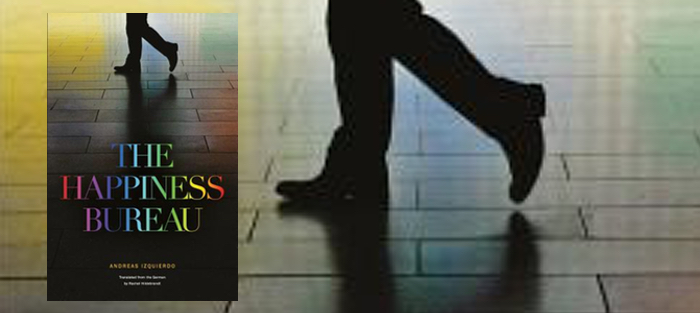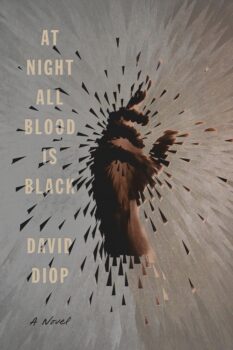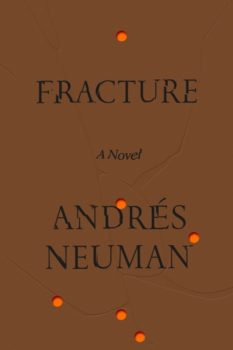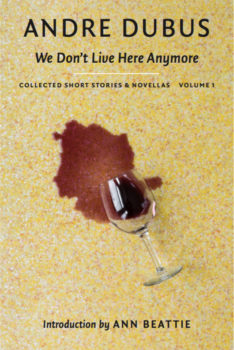Kafka casts such a long shadow that to find happiness in German bureaucracy feels almost revolutionary. Yet this is precisely what we discover in Andreas Izquierdo’s recent novel, The Happiness Bureau (Owl Canyon Press), which has been beautifully translated from the German by Rachel Hildebrandt. Here, the administrative offices are indeed drab and labyrinthine, but they are also beloved by this novel’s protagonist for their isolation from the world. They are home. For several decades, Albert Happy (Albert Glück in the original German, which translates as either “luck” or “happiness”) has followed a system for himself within the system. He cooks a dinner of eggs, for example, after-hours in the industrial-scaled cafeteria, and he regularly cadges breakfast at one of the inevitable morning birthday celebrations among the hundreds of employees, of which he keeps systematic track. For Albert, the building’s power to keep out the public provides security, which is part of his happiness:
You could say that the Agency for Administrative Affairs was the “mother of all administrations,” a powerful, highly independent complex as fully detached from the rest of humanity as the moon orbiting the earth—and just as seldom visited. Even if strangers did enter the building, they could easily get lost. The countless floors, halls and passages, stairs and doors—behind which lurked cryptic departments concealed behind even more cryptic abbreviations—looked identical, and more than a few visitors found themselves back where they had started after spending hours looking for some place else. A labyrinth, which underscored the importance of the office, because something so complicated must… well, it must be tremendously important.
Hidden behind the hesitancy expressed through those ellipses, however, is one of the first hints of the tension that the novel will ultimately explore: the effectiveness of the anonymous bureaucracy in contrast to the messiness of daily life outside the building. For Albert’s office and the exploration of happiness are tightly intertwined. Though his agency purports to help people in need, those very people find its systems impossible to navigate. Likewise, Albert fears the less-regulated world outside. But there is a chink, a humanity, that will eventually enable him to emerge from his gray carapace and experience the world.
Interestingly, the author develops this theme most directly through the idea of art, personified by a painter, Anna, whom Albert will encounter when he at last leaves his building. When Anna files a form, E-45, which is unfamiliar to his office, the hyper-conscientious Albert feels duty-bound to find her in person to resolve her request. Anna is the yin to his yang. Though with her self-containing palindrome of a name, she is allowed little wiggle room for her own development or exploration as a character; she seems to exist primarily to serve as Albert’s guide and romantic sidekick. Like the archetypal Manic Pixie Dream Girl, whom Nathan Rabin describes as “a fantasy figure who exists solely […] to teach broodingly soulful young men to embrace life and its infinite mysteries and adventures,” Anna’s reactions relate only and directly to Albert. And beyond a few false starts, little in the way of conflict emerges between them, which stretches credulity, knowing as we do that Albert has, metaphorically, lived under a rock for all his adult life. But like so much in this novel, their story operates primarily on a symbolic level, their collision making as much an intellectual as an emotional impact once the reader embraces the–Kafkaesque–absurdity of their exaggerated trajectories.
But before Albert encounters Anna, before he ventures out of the agency, the narrative revels in the sense of meaning that Albert finds in his hermetically sealed universe. In particular, his pleasure reaches an almost ecstatic level in his love of paperwork. For him, we learn,
there was nothing more pleasant than the single-minded processing of the wondrous requests. Page by page, they migrated from the accordion file to the outgoing basket. Even after all these years, he still admired the striking beauty of the printed image, the complexity of the syntax combined with great precision of design. The name fields, which were usually the only parts of the forms that the applicants understood fully without assistance, were scaled perfectly for the dimensions of the paper.
In fact, the document is nearly a transcendent object in Albert’s mind, one in which he finds beauty, elegance, and design. He muses,
the miniscule check boxes were lovely. The dainty sections which were to be filled out by administrative personnel only, the adjacent block of instructions about legal appeals with its meticulously enumerated paragraphs, as well as the ingenious inclusion of a way to validate requests or letters or decisions by machine without the need for a personal signature—all of these transformed the page into a work of art.
Reading this, it is hard not to share Albert’s pleasure in the job. In ways, his world recalls Jacques Tati’s masterful film Play Time, which choreographs modernity’s identical cubicles, swirling traffic, and escalators as a baffling but visually charming fun land. And Albert’s pleasure in his office work suggests that a kind of happiness can legitimately be found within the bounds of uniformity, routine, and emotional constraint. Before meeting Anna, Albert believes,
The happiest people were those who did not matter to anyone, who did nothing that conflicted with anyone else’s wishes or plans. This was the only way to find peace, to have a chance at a normal life. Albert was glad that he had his agency, that at night he could stand here and enjoy the stillness around him, the city lights, and the romantic notion that everything, truly everything, was as it should be.
There is something almost persuasive in this, its surface earnestness undercut only by the elbow nudge of the “romantic notion.” For it’s important to note that Albert isn’t a heartless bureaucrat. Rather, he is the naïve innocent.
It is part of the novel’s humor that a bureaucratic form, the mysterious E-45 that crosses Albert’s desk, ultimately forces him from his comfortable office. Once out, his journey is compared with a trip to hell as he first navigates unfamiliar streets and then tries to learn the new system for buying a bus ticket. On board the bus, he encounters blaring music coming from some teenagers’ cell phones and, traumatized, can only “press his hands over his ears, double over as though his stomach hurt, and stare at his shoes.” When he at last reaches Anna Sugus’s address, a small cottage on the outskirts of the city, a new distress overtakes him, as he gazes at the overgrown yard, the roof in need of repair, and finds the “the entire place looked bewitched.” Anna’s house, with its rusty front gate, is not unlike Pippi Longstocking’s ramshackle cottage, and when Anna appears, she has Pippi’s happy, unconventional energy. Albert is smitten from the first, feeling as he looks at her, “as if all the dishes in the cabinet were dancing.” There is no mistaking it; he is destined to be in her thrall.
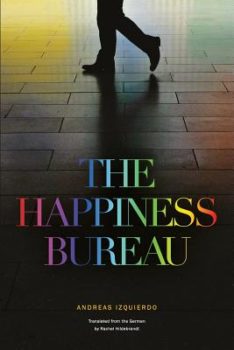 One of the novel’s loveliest passages describes how Anna first encourages Albert to paint. The experience changes him, and he finds himself wondering: “What color is a heartbeat?
What does a word taste like?
What is the fragrance of happiness?” Linguistically, we understand that categories are being blown open, walls pulled down. In fact, poetry has entered Albert’s being. It is the freedom of this that changes his own way of working.
One of the novel’s loveliest passages describes how Anna first encourages Albert to paint. The experience changes him, and he finds himself wondering: “What color is a heartbeat?
What does a word taste like?
What is the fragrance of happiness?” Linguistically, we understand that categories are being blown open, walls pulled down. In fact, poetry has entered Albert’s being. It is the freedom of this that changes his own way of working.
In contrast to Goethe’s plea for work to grow organically, The Happiness Bureau has the aerodynamic construction of a cruise missile, intent on its mission. Action is organized around its central binary: the emotionally constrained world of the office versus the emotionally messy and color-mad world of real people’s needs, further interpreted in Anna’s paintings. Every detail is harnessed to further this tension, beginning with the protagonist’s name, making Mr. Happy in some ways a cousin to many of Dickens’ characters, as well as a part of these authors’ shared project of highlighting absurdity, both bureaucratic and human—Mrs. Malaprop, Tom Gradgrind, the Circumlocution Office, being just a few examples.
Where Dickens grows angry and impatient, however, Izquierdo remains even-tempered and good-natured. He makes his points with earnest logic rather than emotion, as when the narrator argues sincerely on behalf of bureaucracy:
What use were faith, freedom, or the opening up of new worlds if they were not regulated? Administration was the motor that drove all social order, and requests were the engine oil that kept it all running. Without requests, no order; without order, no justice; without justice, no hope; without hope, no faith; without faith, no world.
Humor immediately undercuts this seriousness in the line that follows, though, as the narrator thinks, “Even if you were not moved by this reality, did you really have to demonstrate that by leaving a coffee ring on a request form?”
Also unlike a Dickens novel, where children risk freezing to death in snow, and women die at the hands of abusers, in The Happiness Bureau the stakes are less extreme: money is tight, forms are lost, and jobs are on the line. And the author toes along carefully, almost cerebrally, on the tightrope between realism and satire. Albert Happy’s name, his managing to slip into his job undetected thirty years previous, the ease with which he negotiates a life within the agency, his desperate search to categorize an unfamiliar form; these are the highly imagined yet stylized props of satire. They might remain two-dimensional details in the story’s equation were it not for the author’s gift for detail. Though a pawn in a satirical plot, Mr. Happy is also engagingly human. A reader suspends disbelief, accepts the absurdity of his decades-long cloistering, and discovers the outside world with the joy that is clearly the author’s aim. Despite firm authorial control, there are genuinely moving flights into the philosophical. As Albert recognizes his life is close to its end, for example, he wonders if he had hallucinated any of the circumstances that led him from the building, but decides:
What reason was there to label this happiness as real or fake?
What was happiness exactly?
Because the truth was that people recognized its effects, but this was not happiness itself. Like a little finger pushing a button, but to whose hand did the finger belong?
At its core, The Happiness Bureau is about someone taking a trip. In this case, Albert Happy steps out of gray into living color. As Anna’s wild, creative spirit ignites new life in him, he takes up his work with an opened heart. All the people who might have been theoretically helped by the agency’s efficiency now appear in person, and it is clear that real help for them will require messier contact than moving forms from inbox to outbox. Albert’s office begins to overflow with people, who have rekindled hope in the agency, and through Anna’s guidance, he understands that real happiness is the merging of chaos and order. From thesis, to antithesis, to synthesis, The Happiness Bureau is, in fact, an unabashed manifesto on empathy and its practical application. As Albert’s office becomes a site of pilgrimage and agency of greater good, he finally achieves the happiness bureau of the title.

